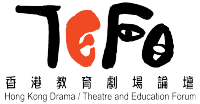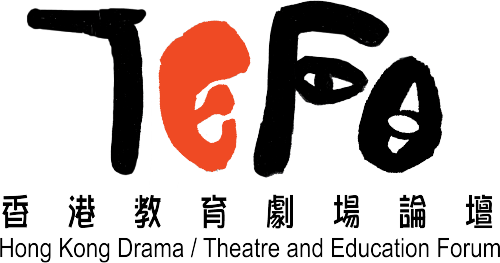Tag: HongKong
A Practical Study of the Application of Active-inquiry Process on Theatre Play: Using the Experience of Creating the Play, Battle for Hong Kong 1941, as an Example(Chinese)|DaTEAsia Vol. 9
The study draws on the playwriting experience of the play for museum theatre, Battle for Hong Kong 1941, to examine the creation of interactive theatre and the design of the interactive section through the active-inquiry process from the point of view of an implementer. The researcher is also the playwright and the designer of the play’s interactive section.
An Alternative Path: A Physical and Metaphorical Group-devised Ethnodrama | DaTEAsia Vol. 7
Graffitopia is a group-devised ethnodrama on the lives of twelve children aged 6 to 12 of different family and socio-economical backgrounds in Hong Kong. It was performed in May 2015 in the Hong Kong Cultural Centre, a public performance venue. In this paper, using Graftopia as a case study, we discuss how researcher-devisingperformers (RDPs) embody, transform and present ethnographic data in the creative process of an ethnodrama, and how such process deepens the RDPs’ understanding of the informants, themselves as well as the devising methodology and aesthetics of ethnodrama. The devising process of the eight RDPs were recorded and studied, and small-group interviews with all the RDPs were conducted towards the last stage of the rehearsal process to investigate their experience and moments of discoveries throughout the creative process. It has been found that the physical, stylised, metaphorical, and reflective devising process and performing style generated an aesthetic space for the RDPs to build not only their understanding of the ethnographic data, but also a strong connection between the RDPs’ selves and the children’s lived experience. Such aesthetic space is crucial to the transformative power, authenticity, research purposes, educational and artistic values of ethnodrama as a form of applied theatre.
Passion, Partnership, Power and Persistence: The Rise and Fall of a Transnational Drama Programme | DaTEAsia Vol. 6
In this article, the authors share their experience in introducing the first award bearing programme in applied theatre and drama education to Hong Kong. Examining the development and challenges within a 10-year transnational partnership between two tertiary institutions, they discuss intercultural issues arising from the collaboration, analyse the impact of the programme on practitioners in Hong Kong and Australia, and reflect on issues related to sustainability. Using the programme as a case study, the authors draw on their experience to bring about discussion on drama education and applied theatre practice in a larger context, suggesting that interculturality, impact and sustainability are three important topics to explore in considering the future for the field in Hong Kong and beyond.
Analyzing Audience Responses: The Case of 1894 Hong Kong Plague Theatre in Education Programme | DaTEAsia Vol. 6
Theatre in education (TIE) is a form of applied theatre that concerns the use of theatre and drama for educational purposes. It is interventionist in nature, and deploys different modes of audience participation to engage its audience within or out of the dramatic acts to explore the issue at stake. Students are invited to revisit and reflect on the knowledge they received and rethink what they have taken for granted. Then a crucial question that follows: What would make the most useful methods of analyzing audience responses in a TIE programme? What is the learning process through theatre like? This paper discusses these questions by drawing findings from a study of TIE programme, 1894 Hong Kong Plague, conducted in Hong Kong in 2014. The programme intended to offer an alternative discourse to the local plague history by utilizing a stylized form of theatre performance and a set of pre- and post-performance activities. In light of Anthony Jackson’s framing in educational theatre and Stuart Hall’s encoding-decoding theory of communication, the paper analyses what attracted and distracted the young audience at 1894 Hong Kong Plague programme. It examines the process through which the students negotiate their live aesthetic encounter and their understanding of the history at issue. At the end, the paper reflects on the implications of the case for TIE audience study.
Theatre Production as a Language Learning Environment for Chinese Students|DaTEAsia Vol. 2
Research has shown that theatre can be used as a tool for English as a second language (ESL) learning in various contexts. However, ESL studies done in Hong Kong have shown that sociocultural factors impact on language learning. I argue that this implies that sociocultural factors could also have a significant impact on language learning in the context of the process of rehearsal for a theatre production. This paper reports the results of a pilot study on Chinese tertiary students involved in preparing a theatre production. Adopting a Vygotskian sociocultural perspective, the study draws on analysis of qualitative data. It aims to answer two research questions: (1) What sociocultural factors shape the experience of English theatre productions in Hong Kong as a language learning environment?; and (2) Are theatre productions good language learning environments in Hong Kong? The results revealed that prior to production, students’ sociocultural background were similar to what other studies have already concluded. This sociocultural background has had an impact on the learning environment in that students were predisposed to explicit instruction in the environment as learning outcomes of the experience. These indicate that theatre productions provided students with multiple learning opportunities, which makes it an appropriate language learning environment.
A Paradigm Shift in the Implementation of Drama Education in Hong Kong Schools|DaTEAsia Vol. 1
A survey about the implementation and effectiveness of drama education in Hong Kong schools reveals that more than 90% of the principals involved agree that drama can exert positive impact on the all-round development of students. Drama does not only enhance students’ generic skills, collaboration skills, self-confidence, learning motivation, language ability, moral awareness and affection; but also facilitates their learning in Chinese Language, English Language, Personal, Social, and Humanity Education and Arts subjects. However, there are only a very small number of schools adopting drama as a formal curriculum and the resource allocated to drama education is very limited. For example, only 1 – 2 periods are allotted to drama education in the schools offering a formal drama curriculum. The inconsistency between the principals’ belief and practice of drama education in schools implies that principals are encountering huge tensions in adopting drama education in their schools. This paper aims to discuss the need for a paradigm shift in implementing drama education from the perspectives of curriculum change and management of change.




